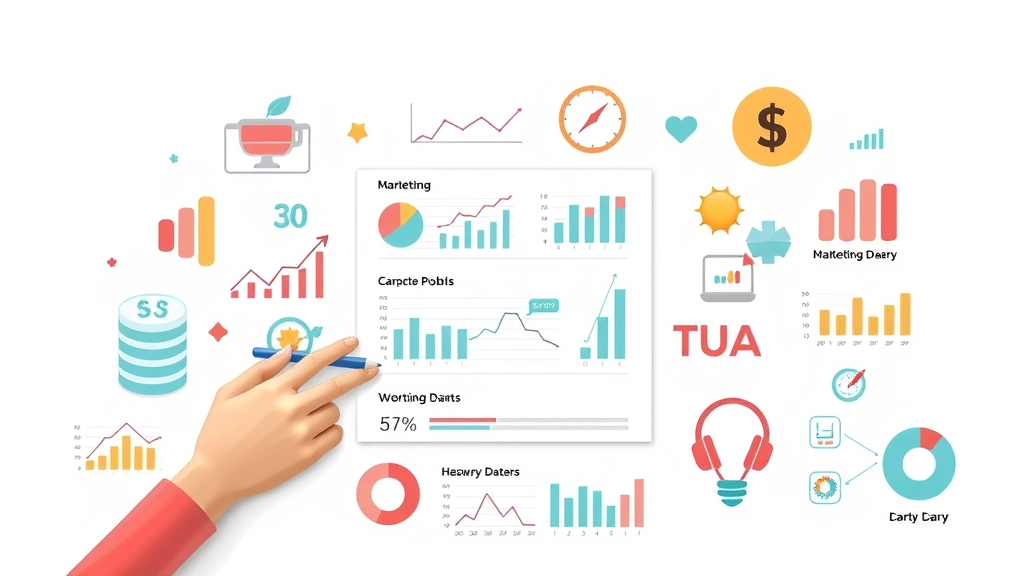Did you know that marketers who leverage marketing data visualization tools are 28% more likely to report above-average ROI? In today’s fast-moving digital landscape, harnessing the power of data isn’t just an advantage—it’s a necessity. Marketing data visualization transforms raw numbers into engaging graphics, unlocking hidden insights and giving your business a measurable edge. In this guide, you’ll explore how to turn your mountain of marketing data into high-impact visual stories that fuel smarter decisions, foster teamwork, and deliver real results.
Unveiling the Power: Marketing Data Visualization and Why It Matters

- Did you know that marketers who leverage marketing data visualization tools are 28% more likely to report above-average ROI? Discover why adopting marketing data visualization is the game-changer for your business strategy.
In today’s data-driven marketing environment, effective visualization is the secret weapon savvy marketers use to transform mountains of raw data into actionable insights. Marketing data visualization helps organizations spot trends, measure key metrics, and drive higher returns on their marketing investments. Whether you’re running digital marketing campaigns or analyzing data from multiple sources, presenting data visually makes complex information easily digestible for every team member—from analysts to executives.
The importance of marketing data visualization goes beyond just making pretty charts and graphs. It’s about telling your data’s story in a way that supports rapid decision-making and strategic alignment. By implementing the right data visualization tools, you empower your teams to monitor campaign performance in real-time, identify winning tactics faster, and ensure every marketing effort is purposeful and measurable. Ultimately, mastering data visualization in marketing leads to deeper customer understanding, stronger campaigns, and business growth.
Essential Concepts: Understanding Marketing Data Visualization
- Defining marketing data visualization: More than pretty pictures
- How data visualization turns raw marketing data into actionable insights
- The impact of marketing data visualization on decision-making
"Data visualization is not just a tool—it’s the language of marketing intelligence." – Industry Thought Leader

At its core, marketing data visualization is the process of representing marketing data through charts and graphs , dashboards, and interactive dashboards. Instead of sifting through endless spreadsheets of raw data, marketers use visualization tools to spot trends, track campaign ROI, and communicate results to stakeholders in an impactful way.
Why does this matter? When complex data becomes visual, marketers gain the ability to act on insights in real time. For example, a line chart showing sudden drops or spikes in traffic can quickly alert your team to issues or opportunities in a campaign. Interactive dashboards further empower collaboration, letting everyone—regardless of their technical ability—understand performance and contribute ideas. The right data visualization in marketing unlocks clarity, so teams focus on what moves the needle, not manual data crunching.
Unlocking the Benefits: Why Use Data Visualization in Marketing?
- Faster trend identification and response
- Enhanced team collaboration with visual data storytelling
- Improving campaign performance through visualization tools
Using data visualization tools in marketing accelerates your path to opportunity. Instead of waiting until the end of a quarter, real-time visual analytics help you identify emerging trends in customer behavior, campaign engagement, and digital marketing spend. Responding quickly can mean the difference between a missed opportunity and a major win.
The power of storytelling comes alive when you use charts and graphs to share results. Visual reporting fosters team collaboration by making complex data easy to discuss. When teams see the story behind the numbers—like a bar chart highlighting campaign winners or a pie chart illustrating audience segments—everyone aligns around strategy goals. Finally, using sophisticated visualization tools leads to improved marketing campaign performance through better analysis and continuous optimization.
Data Visualization Tools: Comparing Top Solutions for Marketing Data
Power BI: A Leading Data Visualization Tool for Marketing Data
Power BI by Microsoft is a top-ranked data visualization tool , widely used for analyzing marketing data. Power BI offers flexibility in importing huge volumes of marketing data from sources like Google Analytics, Facebook Ads, and CRM systems. With its drag-and-drop features, non-technical marketers can design dashboards featuring bar charts, line charts, and key metrics widgets. Power BI excels at handling large data sets, making it a favorite for enterprises and agencies running complex marketing campaigns.
Interactive dashboards in Power BI allow marketers to drill down into specific segments, campaigns, or even ad-level data points. This granularity makes it easier to identify which parts of your marketing efforts are paying off and which need realignment. Robust integration options—ranging from SQL databases to web APIs—ensure your visualizations are always fed with the most current data.
Other Visualization Tools: Tableau, Google Data Studio, and More
While Power BI leads the pack, other visualization tools like Tableau and Google Data Studio are popular for their user-friendly interfaces and strong connections to common data sources. Tableau shines with interactive, customizable visuals, letting marketers build dashboards that blend multiple data streams into a single view. Google Data Studio stands out for its cost-effectiveness—it’s free—and smooth integration with Google Sheets, Analytics, and Ads.
These tools often support various chart types, including stunning line charts and pie charts, and enable teams to share easy-to-understand dashboards with clients. When comparing data visualization tools, always evaluate their compatibility with your existing marketing data sources, ease of use for your team, and collaborative features. Investing in the right tool ensures long-lasting impact on your marketing strategy.
| Tool | Features | Pricing | Ease of Use | Data Source Integration |
|---|---|---|---|---|
| Power BI | Advanced analytics, custom visuals, real-time dashboards | Paid, enterprise tier available | Moderate (learning curve) | Extensive (SQL, REST, Excel, APIs) |
| Tableau | Interactive dashboards, deep customization, AI insights | Paid, public tier free | Moderate (learning curve) | Wide (databases, web apps, cloud) |
| Google Data Studio | Simple, connects to Google Suite, automated updates | Free | Easy | Seamless (Google Analytics, Sheets, Ads) |
- Choosing the right data visualization tool for your marketing campaigns
- Factors to consider: data sources, chart variety, and collaboration

Key Visuals: Charts and Graphs in Marketing Data Visualization
Bar Chart, Pie Chart, and Line Chart: When and Why to Use Them in Marketing
- Bar charts for comparing campaign performance
- Pie charts for audience segmentation
- Line charts for monitoring trends over time
Understanding when to use a bar chart , pie chart , or line chart is crucial. Bar charts are perfect for comparing campaign performance across channels or products—visualizing just how impactful a Facebook ad campaign was compared to email or organic traffic. Pie charts, meanwhile, offer a snapshot of segmentation, showing how your total audience splits by demographics or behavior. Line charts shine in digital marketing, making it easy to spot trends in web traffic, conversion rates, or sales over time.
When combined in a marketing dashboard, these chart types help marketers extract key insights at a glance. By choosing the right visualization for each metric, it’s possible to clarify data points and drive faster, more effective decisions. Remember, the goal is always to make your data as actionable as possible—so pick the visual that highlights your most important metrics.

Visualizing Data Points in Marketing Dashboards
- How to highlight crucial data points for stakeholders
- Best practices for clear marketing dashboards
Clear marketing dashboards highlight essential data points —like cost per click, customer acquisition cost, and top-performing campaigns—using color coding, trend lines, and annotations. When a dashboard draws the eye to what matters most, stakeholders can make decisions quickly without digging through complex data or dense reports.
Best practices for presenting data include limiting each view to a handful of key metrics, using consistent chart types and labeling, and employing interactive elements that let users filter and deep-dive into specific segments. The result is a marketing dashboard that tells a compelling story and empowers your team to take action.
Optimizing Digital Marketing with Data Visualization
- Case studies: Marketing campaigns transformed by marketing data visualization
- Measuring digital marketing ROI with visualization tools
Digital marketing success relies on continual optimization—and data visualization tools are essential for measuring ROI and spotting opportunities to scale. For example, one e-commerce brand used an interactive dashboard to visualize ad spend against profit margins; the team quickly saw that reallocating budget to specific channels improved ROI by 40%.
Using visualization tools helps teams monitor performance in real-time, recognizing winning tactics and underperforming segments. Campaigns are improved faster, increasing customer engagement, and boosting digital marketing returns—all while making reporting more transparent for clients and internal stakeholders.

Turning Raw Data into Strategy: Sourcing and Preparing Your Marketing Data
- Identifying reliable data sources for marketing data visualization
- Cleaning and structuring data for visualization tools
- Ensuring data quality for accurate visualization
"Good data in means powerful insights out—never underestimate your data sources."

Every powerful marketing data visualization starts with high-quality raw data. The first step is sourcing reliable data from trustworthy platforms—think Google Analytics, CRM systems, ad platforms, and customer feedback surveys. Next, marketers must clean and structure this data to ensure accuracy and compatibility with chosen visualization tools. This process may involve removing duplicates, correcting errors, and standardizing formats in tools like Excel or Google Sheets.
Remember, the quality of your visual insights is only as good as your data sources. Regular data audits, field mapping, and validation checks are critical to avoid misleading charts and graphs. Investing time in proper data preparation pays off with reliable, actionable dashboards that enable confident marketing decisions.
Step-by-Step: Implementing Marketing Data Visualization in Your Campaigns
- Step 1: Choose the right data visualization tools
- Step 2: Integrate marketing data sources
- Step 3: Select charts and graphs for each objective
- Step 4: Customize visualizations for your audience
- Step 5: Iterate and optimize based on feedback

Implementing marketing data visualization is a straightforward process that pays big dividends. First, evaluate which visualization tools best align with your team's needs—consider Power BI, Tableau, or Google Data Studio. Next, securely connect your data sources, ensuring accurate and timely data at every stage.
Choosing the right chart type for each KPI is critical to spotlight essential trends and comparisons. Personalize dashboards with your brand’s look and tailor views for specific teams or executives. Remember to collect feedback, continuously test new visualizations, and iterate based on what drives understanding and action across your stakeholder groups.
Troubleshooting: Common Challenges in Marketing Data Visualization
- Overcoming data overload and complexity
- Ensuring accessibility and clarity for all stakeholders
- Aligning visualization with marketing campaign objectives

Even experts face challenges in presenting data effectively. Common pitfalls include data overload—cramming too many charts and data points into one view—and failing to tailor content for diverse audiences. Overly complex data can lead to misinterpretation and strategic missteps.
To overcome these hurdles, focus your storytelling on essential metrics that tie directly to campaign objectives. Use consistent layout, color, and chart types, and limit dashboard widgets to those that drive decisions. Finally, test dashboards regularly with stakeholders to ensure clarity and actionable insights for every user.
Expert Insights: Quotes on the Impact of Marketing Data Visualization
"Visualization tools empower marketers to communicate with clarity and impact—bridging the gap between data and decisions." – Marketing Analyst
The growing array of visualization tools acts as a bridge—connecting complex marketing data with business leaders, campaign managers, and clients. According to industry experts, visualization is the single fastest path to turning marketing data into strategy. By leveraging the right tools and techniques, marketers make informed decisions, communicate powerfully, and ensure every campaign is optimized for maximum return on investment.
Embracing data visualization in marketing turns every data point into a catalyst for improvement, innovation, and growth. The path from overwhelming spreadsheets to crystal-clear charts and actionable dashboards is the key to thriving in a digitally competitive landscape.
People Also Ask
What is data visualization in marketing?
- Marketing data visualization is the process of representing marketing data using visual elements such as charts, graphs, and dashboards to extract insights and communicate performance more efficiently.

What are the 5 C's of data visualization?
- Context – Understanding the background of your marketing data
- Clarity – Ensuring visuals simplify data, not complicate it
- Credibility – Using reliable data sources and accurate charts
- Consistency – Employing uniform styles and labeling
- Communication – Conveying the intended message effectively
What are the 3 C's of data visualization?
- Clarity – Make data easy to understand
- Consistency – Keep visuals uniform for easier comparison
- Comparability – Enable meaningful side-by-side analysis
What are the 7 stages of data visualization?
- Understand your objectives
- Collect marketing data
- Clean and prepare the data
- Select appropriate visualization tools
- Design charts and dashboards
- Interpret and derive insights
- Communicate findings and take action
Advanced Tips: Elevating Your Marketing Data Visualization
- Incorporate interactivity for deeper insights
- Automate data updates in your visualization dashboard
- Align visualizations with overall business KPIs

Ready to take your marketing data visualization further? Incorporate interactive features—like filtering, hovering for tooltips, or clickable drill-downs—to let users explore data at their own pace. Automate your dashboard updates using integrations with Google Sheets, CRMs, and analytics tools, ensuring your decisions are always based on current insights.
Finally, align every visualization with your core business KPIs, not just vanity metrics. Every chart, graph, or widget should serve a specific purpose and connect to your broader marketing and business goals. With these strategies, your dashboards evolve from static reports to living, strategic assets.
FAQs
- How do I choose the best marketing data visualization tool? Identify your key business needs—such as data source compatibility, level of automation, and team technical skill—then compare tools like Power BI, Tableau, and Google Data Studio based on their features and ease of use for your team.
- Which data points should marketers focus on? Prioritize metrics tied to your objectives, such as conversion rates, ROI, cost per acquisition, channel performance, and customer segments. Focusing on these ensures your visualizations drive meaningful action.
- What are the most common mistakes made in marketing data visualization? Common mistakes include overloading dashboards, using inconsistent chart types, ignoring data integrity, or prioritizing aesthetics over clarity. Keep it simple and relevant to maximize the impact.
- How often should marketing dashboards be updated? At minimum, update dashboards weekly for active campaigns. For fast-moving digital marketing initiatives, daily or real-time updates ensure timely decisions with the freshest data.
Summary and Next Steps: Harnessing Marketing Data Visualization
- Recap: Why marketing data visualization is mission-critical
- Start integrating top visualization tools with your marketing data today
- Transform marketing campaigns using charts, dashboards, and actionable visual insights
Ready to unlock game-changing insights with marketing data visualization?
- Your next customer is searching online right now—can they find you? Schedule a free strategy session and let’s make your business the one they connect with. Book your free marketing strategy with our team today. Call: 314-560-4642 or visit: https://marketingconnectionsllc.com/get-in-touch
Ready to put your marketing data to work? Choose a visualization tool, integrate your data, and build a dashboard that puts insights into action—starting today.
To deepen your understanding of marketing data visualization, consider exploring the following resources:
- “5 Data Visualization Best Practices for Marketing Reports” ( dolphinanalytics.co.uk )
This article offers practical tips on creating clear and effective marketing visualizations, emphasizing simplicity, focus on key metrics, and consistency in design.
- “How to Master Data Visualization in Marketing” ( reportingninja.com )
This guide provides an overview of top data visualization tools like Microsoft Power BI, Looker Studio, and Tableau, detailing their features and how they can enhance marketing analytics.
By leveraging these insights, you can transform complex marketing data into actionable visual stories that drive smarter decisions and measurable results.
 Add Row
Add Row  Add
Add 






Write A Comment